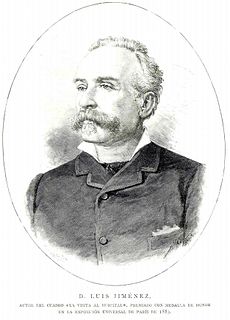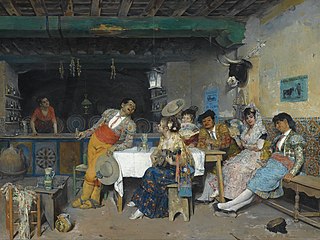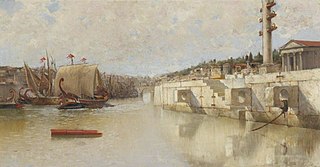
Salvador Viniegra y Lasso de la Vega was a Spanish historical painter and patron of the arts.

José Sotero de Madrazo y Agudo was a Spanish painter and engraver; one of the primary exponents of the Neoclassical style in Spain. He was the patriarch of a family of artists that included his sons Federico and Luis; and his grandsons, Raimundo and Ricardo.

Bernardo Germán de Llórente was a Spanish painter of the late-Baroque period. He was active in Seville where he was one of the followers of Murillo and made a name with his devotional paintings of the Virgin Mary. He also painted portraits and still lifes with trompe-l'œil effects.

Eduardo Rosales Gallinas was a Spanish painter. He was an adherent of the Italian-based art movement known as "Purismo" and specialized in historical scenes.

Manuel García y Rodríguez was a Spanish costumbrista and landscape painter, who also painted Orientalist scenes.

José Jiménez Aranda was a Spanish painter and brother of the painters Luis Jiménez Aranda and Manuel Jiménez Aranda.

Ángel Lizcano Monedero y Esteban was a Spanish painter and illustrator. He specialized in Costumbrista and historical scenes.

Valentín Carderera y Solano was a Spanish painter, erudite scholar and collector. He was named honorary court painter during the reign of Isabel II.
Andres Rossi was a Spanish artist. He worked as a painter, draughtsman, print maker, sculptor and writer in Madrid and Seville.

Jose Aranda was a Spanish-born French painter of genre scenes; many in costumbrista style. His brothers, José and Manuel also became painters.

Manuel Cabral Aguado-Bejarano was a Spanish painter in the Romantic style; best known for his Costumbrismo scenes.

Joaquín Domínguez Bécquer was a Spanish Costumbrista painter.

José García Ramos was a Spanish painter and illustrator; known primarily for his costumbrista scenes.

Francisco Peralta del Campo was a Spanish painter; now best remembered for his costumbrista and Orientalist scenes.

Rafael Senet Pérez was a Spanish painter and watercolorist, known for his costumbrista and Orientalist scenes. He also created numerous vedute of Venice.

Justo Ruiz Luna was a Spanish painter, watercolorist and pastellist; best known for his maritime scenes.

Manuel Ramírez Ibáñez was a Spanish painter; primarily known for historical and genre scenes.

José María Romero López was a Spanish painter in the Romantic style. Some sources give his year of death as 1880 or 1888.

Eduardo Cano de la Peña was a Spanish painter in the Romantic style; specializing in historical scenes.





















